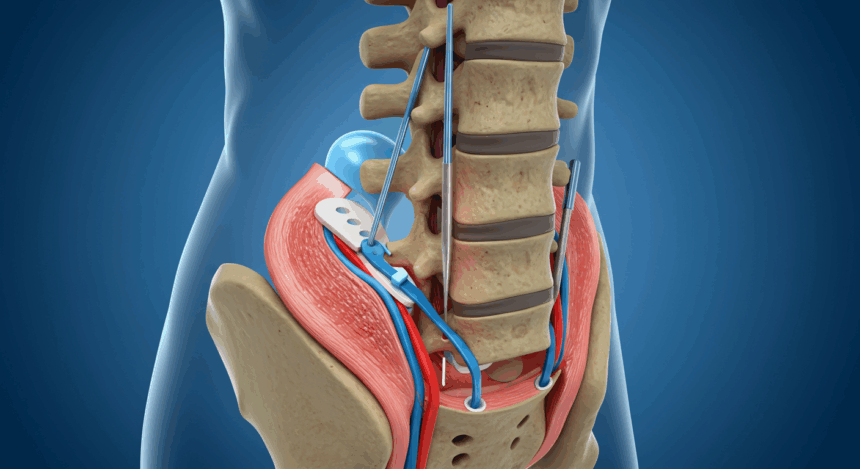A Cutting-Edge Solution for Lumbar Spine Disorders
K-OLIF stands for Keyhole Oblique Lumbar Interbody Fusion, an advanced form of spinal fusion surgery that treats lower back pain caused by disc degeneration, spinal instability, or deformities. It is a minimally invasive, highly precise procedure that uses a keyhole-sized incision through an oblique (angled) approach to reach the lumbar spine. By avoiding muscles and nerves, K-OLIF offers faster recovery, less pain, and excellent long-term stability.
🧠 What is K-OLIF?
K-OLIF is a specialized technique in which the surgeon accesses the lumbar spine (lower back) through a natural corridor between the muscles, rather than cutting through them. This is done through a small lateral incision on the side of the abdomen, which gives access to the disc space without disturbing major nerves or blood vessels. A spacer or cage filled with bone graft is placed in the disc space to restore height and promote fusion of the vertebrae, followed by fixation with screws or rods if needed.
✅ Key Advantages of K-OLIF
-
Minimally Invasive: Tiny incisions result in less tissue damage and scarring.
-
Muscle-Sparing Approach: Preserves the psoas and major back muscles.
-
Reduced Nerve Injury Risk: Avoids the spinal canal, minimizing nerve complications.
-
Faster Recovery: Patients often walk within 24–48 hours post-surgery.
-
Shorter Hospital Stay: Most patients are discharged within 2–3 days.
-
Less Blood Loss: Significantly less than traditional open fusion surgeries.
-
Enhanced Stability: Long-term spine alignment and relief from pain or nerve compression.
🩺 Who Needs K-OLIF?
K-OLIF is ideal for patients with:
-
Degenerative disc disease
-
Lumbar spinal instability
-
Spondylolisthesis
-
Foraminal stenosis
-
Recurrent disc herniation
-
Failed back surgery syndrome
-
Spinal deformity correction (in selected cases)
It is especially beneficial for those seeking less invasive alternatives to traditional spinal fusion.
⚙️ How is K-OLIF Performed?
-
Positioning: The patient lies on their side under general anesthesia.
-
Keyhole Access: A small (2–3 cm) incision is made in the flank area.
-
Oblique Approach: Using real-time fluoroscopy and tubular retractors, the surgeon reaches the spine through a natural gap between muscles.
-
Disc Removal & Spacer Placement: Damaged disc material is removed, and a bone-filled cage is inserted to restore height and alignment.
-
Fixation: Pedicle screws or lateral plates may be used for stability.
-
Closure: Minimal suturing is required, with little post-op discomfort.
👨⚕️ Expertise Matters – Dr. Praveen Saxena’s Role
K-OLIF is a highly technical procedure that requires precision, planning, and deep anatomical knowledge. Dr. Praveen Saxena, one of India’s most experienced spine surgeons, is trained in advanced fusion techniques including OLIF, TLIF, and XLIF. With international fellowships and a track record of successful outcomes, he offers patient-specific, minimally invasive spinal care with world-class expertise.
💬 Patient Experiences
“I had constant back pain and weakness in my legs due to spondylolisthesis. After K-OLIF by Dr. Saxena, I was walking without pain within 2 days. No big scar, no major pain!”
— Mr. R. Shah, Age 52
“I was worried about traditional fusion surgery, but this approach through a tiny incision worked wonders for my slipped disc. It changed my life.”
— Mrs. S. Iqbal, Age 46
Quick Snapshot: K-OLIF vs Traditional Fusion
| Feature | K-OLIF | Traditional Fusion |
|---|---|---|
| Incision Size | 2–3 cm (Keyhole) | 8–12 cm (Large) |
| Muscle Damage | Minimal | Significant |
| Recovery Time | 2–4 weeks | 6–12 weeks |
| Hospital Stay | 2–3 days | 5–7 days |
| Blood Loss | Very Low | High |
| Nerve Risk | Low | Moderate to High |

